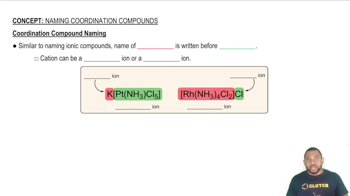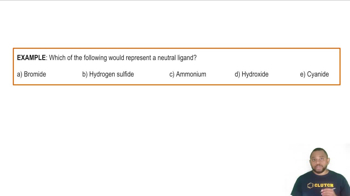Ch.23 - Transition Metals and Coordination Chemistry

Brown15th EditionChemistry: The Central ScienceISBN: 9780137542970Not the one you use?Change textbook
Chapter 23, Problem 38
Complete the exercises below. Write names for the following coordination compounds: d. [Ir(NH₃)₄(H₂O)₂](NO₃)₃
 Verified step by step guidance
Verified step by step guidance1
Identify the central metal ion in the coordination compound, which is Iridium (Ir).
Determine the oxidation state of the central metal ion. Since the complex is neutral and the nitrate ion (NO₃⁻) has a charge of -1, the overall charge of the coordination sphere [Ir(NH₃)₄(H₂O)₂] must be +3 to balance the three nitrate ions. Therefore, Iridium is in the +3 oxidation state.
List the ligands in the coordination sphere. The ligands are four ammonia (NH₃) molecules and two water (H₂O) molecules.
Name the ligands in alphabetical order. Ammonia is named 'ammine' and water is named 'aqua'. Therefore, the ligands are named as 'tetraammine' and 'diaqua'.
Combine the names of the ligands with the metal and its oxidation state to form the full name: 'tetraammine diaqua iridium(III) nitrate'.
Key Concepts
Here are the essential concepts you must grasp in order to answer the question correctly.
Coordination Compounds
Coordination compounds consist of a central metal atom or ion bonded to surrounding molecules or ions, known as ligands. The arrangement and type of ligands influence the properties and reactivity of the compound. Understanding the structure of coordination compounds is essential for naming them correctly.
Recommended video:
Guided course

Coordination Compound Naming
Ligands
Ligands are ions or molecules that donate a pair of electrons to a central metal atom in a coordination compound. They can be classified as monodentate (binding through one atom) or polydentate (binding through multiple atoms). The nature and number of ligands affect the overall charge and stability of the coordination complex.
Recommended video:
Guided course

Ligands Example
Nomenclature of Coordination Compounds
The nomenclature of coordination compounds follows specific rules set by the International Union of Pure and Applied Chemistry (IUPAC). The name typically includes the ligands listed in alphabetical order, followed by the metal's name and its oxidation state in Roman numerals. Understanding these rules is crucial for accurately naming coordination compounds.
Recommended video:
Guided course

Coordination Compound Naming
Related Practice
